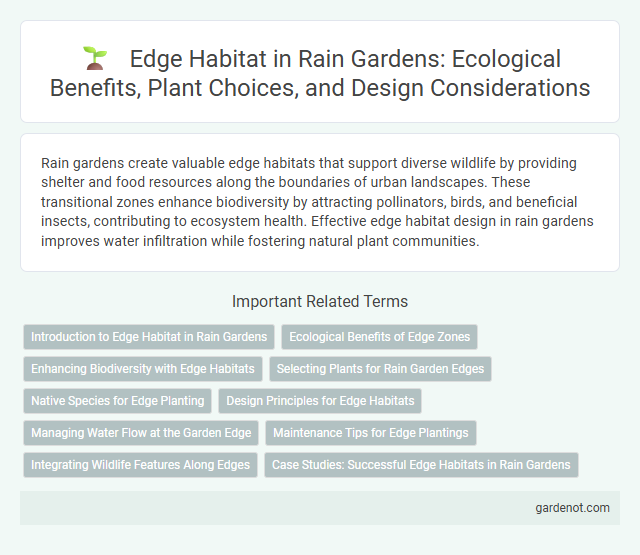Rain gardens create valuable edge habitats that support diverse wildlife by providing shelter and food resources along the boundaries of urban landscapes. These transitional zones enhance biodiversity by attracting pollinators, birds, and beneficial insects, contributing to ecosystem health. Effective edge habitat design in rain gardens improves water infiltration while fostering natural plant communities.
Introduction to Edge Habitat in Rain Gardens
Edge habitats in rain gardens create vital transitional zones where aquatic and terrestrial ecosystems meet, supporting diverse plant and animal species. These areas enhance filtration and water absorption by integrating native vegetation capable of thriving in fluctuating moisture conditions. By fostering biodiversity and stabilizing soil, edge habitats contribute to the ecological function and resilience of rain gardens.
Ecological Benefits of Edge Zones
Edge habitats in rain gardens create unique microenvironments that support increased biodiversity by providing diverse food sources and shelter for pollinators, birds, and beneficial insects. These zones enhance ecosystem resilience by facilitating species interactions and nutrient cycling, improving soil health and water filtration. The ecological benefits of edge zones contribute to more effective stormwater management and habitat connectivity within urban landscapes.
Enhancing Biodiversity with Edge Habitats
Edge habitats in rain gardens create transitional zones between aquatic and terrestrial environments, supporting diverse plant and animal species. These microhabitats increase biodiversity by providing shelter, food, and breeding areas for pollinators, amphibians, and birds. Utilizing native vegetation in edge habitats improves ecosystem resilience and promotes natural pest control within urban landscapes.
Selecting Plants for Rain Garden Edges
Selecting plants for rain garden edges requires prioritizing species tolerant of both wet and dry conditions due to fluctuating moisture levels typical at the garden's perimeter. Native grasses and sedges like Carex pendula or Juncus effusus are ideal, providing erosion control and habitat value while enhancing biodiversity. Incorporating flowering perennials such as Asclepias tuberosa supports pollinators and contributes to a resilient edge habitat that seamlessly transitions to surrounding landscapes.
Native Species for Edge Planting
Edge habitats in rain gardens thrive with native species such as switchgrass (Panicum virgatum), blue flag iris (Iris versicolor), and New England aster (Symphyotrichum novae-angliae), which provide excellent erosion control and support local biodiversity. These plants tolerate fluctuating moisture conditions common in transitional zones between wet and dry areas, enhancing habitat complexity and attracting pollinators like butterflies and native bees. Incorporating native edge species fosters ecological resilience while improving the overall functionality of rain gardens.
Design Principles for Edge Habitats
Edge habitats in rain garden design maximize biodiversity by integrating transitional zones between aquatic and terrestrial environments. Effective design principles include creating gradual slopes to support diverse plant species, selecting native vegetation that thrives in fluctuating moisture levels, and incorporating structural complexity with layered plants to provide shelter and food resources. These strategies promote resilience and ecological balance, enhancing habitat function and wildlife connectivity.
Managing Water Flow at the Garden Edge
Managing water flow at the rain garden edge enhances edge habitat by directing runoff into native plants that stabilize soil and filter pollutants. Strategic placement of berms and swales along the perimeter slows water movement, promoting infiltration while preventing erosion. This approach supports diverse wildlife by creating microhabitats and maintaining moisture levels critical for edge species.
Maintenance Tips for Edge Plantings
Maintaining edge plantings in rain gardens requires regular monitoring to prevent invasive species from encroaching and to ensure native plants thrive. Watering during dry periods and mulching help retain soil moisture and reduce weed growth along the garden's perimeter. Pruning dead or overgrown vegetation promotes healthy root systems and enhances the structural integrity of edge habitats.
Integrating Wildlife Features Along Edges
Incorporating wildlife features along the edges of a rain garden enhances habitat diversity by providing shelter, nesting sites, and foraging opportunities for native species such as pollinators and amphibians. Strategically planting native grasses, shrubs, and wildflowers at these boundaries creates microhabitats that support edge-dwelling birds, insects, and small mammals. This edge habitat integration promotes ecological connectivity and resilience within urban and suburban landscapes.
Case Studies: Successful Edge Habitats in Rain Gardens
Case studies of successful edge habitats in rain gardens reveal significant improvements in biodiversity and stormwater management. Plant species like sedges, rushes, and native wildflowers create microhabitats that support pollinators, amphibians, and beneficial insects, enhancing ecological resilience. Notable examples include Portland's Tabor Rain Garden and Chicago's Northerly Island Rain Garden, where strategic edge planting has maximized water infiltration and habitat connectivity.
Edge habitat Infographic

 gardenot.com
gardenot.com